THE HISTORY OF THE CELLA DI CIARDO
In the heart to the busy market of San Lorenzo in Florence, a marble plaque above the door of 33, Via Sant’Antonino, in the heart of the busy San Lorenzo Market in Florence, we can read the words “CANTO DELLA CELLA DI CIARDO”.
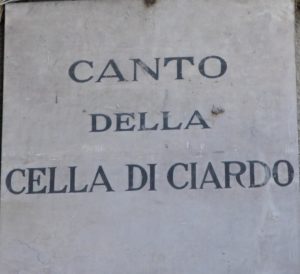
In medieval times canto was the name given to street corners where Florentines would meet to sing and listen to story tellers. As we walk around the historic centre of Florence we will come across other canti like the Canto della Pace in the district of Sant’Ambrogio, the Canto dei Diavoli in Via Strozzi and the Canto dei Bischeri in Piazza Duomo, to name but a few.
The Canto della Cella di Ciardo is the corner between Via Sant’Antonino and Via dell’Ariento where Ciardo Torrigiani had his cella or tavern. As Marcello Vannucci tells us in ‘Le Grandi Famiglie di Firenze’: “The Torrigiani were wine merchants, they had a tavern near the church of San Lorenzo, in the vicinity of Via dell’Ariento. Ciardo is the first of the Torrigiani family, at the beginning of the XIV century, to make a fortune”.
In Medieval times the narrow alleyways of the overcrowded quarter of San Lorenzo, with their humble shacks and workshops were called “Camaldoli” and the Cella di Ciardo represented a welcoming, hospitable meeting place for the popolo minuto, the artisans and shopkeepers.
“The importance of taverns or celle is demonstrated by the fact that streets and squares were named after them as in the case of the well-known Cella di Ciardo in San Lorenzo. We can trace the name of the corner between Via dell’Ariento e Via Sant’Antonino, Canto alla Cella di Ciardo, in official Florentine documents from the XIV to the XIX century” Luciano Artusi explains in his book ‘Le Arti e Mestieri di Firenze’
The Cella or tavern appears to have been built on the site of an ancient basilica or church. In Giovanni Targioni Tozzetti’s book about Tuscany, dated 1751, we can read:
“the columns in the cellar of a hostelry in the Camaldoli of San Lorenzo, called the Cella di Ciardo, would seem to have been part of a pre-existing basilica.”
This theory on the origin of the Cella is further confirmed by another historian, Guido Carocci, who wrote in 1911: “The Cella di Ciardo was a kind of monumental loggia supported by octagonal pillars where we can see the coat of arms of the Comandatore. Before the building was completely transformed, I remember seeing the remains of this interesting structure that conserved all the characteristics of the XIV century.”
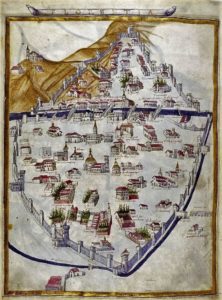
Map of Florence with the Sant’Antonio of Vienne monastery
Carocci’s description of the Cella as a “monumental loggia supported by octagonal
pillars” would explain the popularity of the tavern with the people of the Camaldoli, who, as we said before, lived in overcrowded and squalid hovels.
These two historians suggest that the loggia was part of a previous building, presumably a church or maybe the cloisters of a monastery and, indeed, if we look at the map of Florence dated 1472 we can make out, in the bottom right hand corner, the monastery of Sant’Antonio of Vienne which lay between the Church of San Lorenzo and the Faentina gateway in the ancient city walls. This complex included a hospital and a hostel for pilgrims and was presided over by a prior who went by the name of “Comandatore”.
The octagonal pillars referred to by Tozzetti and Carocci can still be seen today in the leather shop ‘I’Mago’ which opens onto Via dell’Ariento at number 35/r, just round the corner from the front door of the apartments ‘Le Celle di Ciardo’. On the ground floor of the shop we can make out two elegant octagonal columns, partly incorporated in the plaster of the walls. The capitols of the columns are decorated in a floral style; on the left hand
column we can see two running dogs while the right hand column is decorated with two pastoral staves and three roses, presumably the symbols of the Comandatore of the monastery of Sant’Antonio. In the cellar of the watchmaker and jeweller’s shop ‘La Meridiana’ there is evidence of a vaulted ceiling and medieval masonry, while under the leather shop an enormous octagonal stone pillar is still partially visible, further confirmation of the historians’ theory that the Cella was indeed built on the ruins of an ancient monastery. (Please note that these cellars are not open to the public.)

Capitol with running dogs
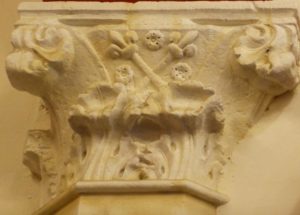
Capitello con pastorali
Capitol with pastoral staves
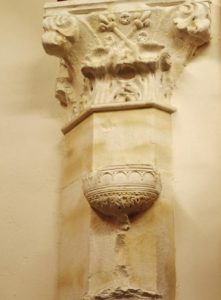
Column with the chalice of the Vinattieri
At a later date a decorative chalice was added to the right hand column in the leather shop, the chalice being the symbol of the wine guild (Arte dei Vinattieri) of which Ciardo, as taverner, would have been a member.
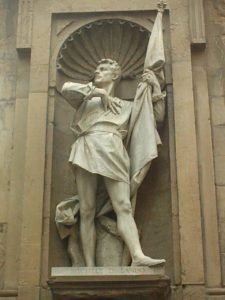
The statue of Michele di Lando at the Mercato del Porcellino
The historic Florentine registry archives tell us that in 1382 the tavern, run by Ciardo di Betto a descendant of Ciardo di Torrigiani, was destroyed when the owner fell into disgrace following the uprising of the Ciompi workers. The Ciompi (wool carders) were the poorest labourers in the textile industry and they had no power or representation in the social system of the Arts and Crafts guilds. In consequence of their revolt they were granted representation and a new guild was founded but following an economic crisis they soon found themselves out of work and they then resumed their protests with violent attacks of arson and looting. As a result the Signoria, the governing body of the city, annulled the guild and the leaders of the revolt were punished. One of these was Ciardo di Betto who had sympathized with the rebels and had encouraged them to meet in his tavern. He and another rebel leader, Giorgio Scali, were beheaded while Michele di Lando was exiled and the Cella di Ciardo was burnt to the
ground as we can read in Gino Capponi’s ‘History of the Republic of Florence’, 1876:“…they went around, having first burnt down the house of Ciardo the wine merchant who had been beheaded as a follower of Giorgio Scali.” After the fire the
premises were turned into living quarters and dating from the 1427 land register we can follow a succession of various proprietors.
In 1536 the Cella di Ciardo reopened as a tavern with its old name under a new proprietor, Guglielmo di Niccolò Brunetti. It continued to be famous all through the XVI century for its wine, its food and its prostitutes. In the mid 1500s it belonged to Marco and Giovan Gualberto di Vieri, dealers in second hand goods and was run by the publican Gianni d’Andrea.
The Cella di Ciardo probably underwent reconstruction work during the period 1856–1871 when the Camaldoli di San Lorenzo were demolished to make room for the new Central Market. In the years that Florence was Italy’s capital, the facades of all the buildings lining Via dell’Ariento opposite the new market were restored in a neoclassic style, favoured by the architect of the moment, Giuseppe Poggi.
The building was acquired by the present owners in the mid XX century and converted into apartments above the shops in 2015.
Via Sant’Antonino 33 fu acquistato dagli attuali proprietari a metà del XX secolo ed è stato restaurato e convertito in appartamenti, al primo e secondo piano, nel 2015.




